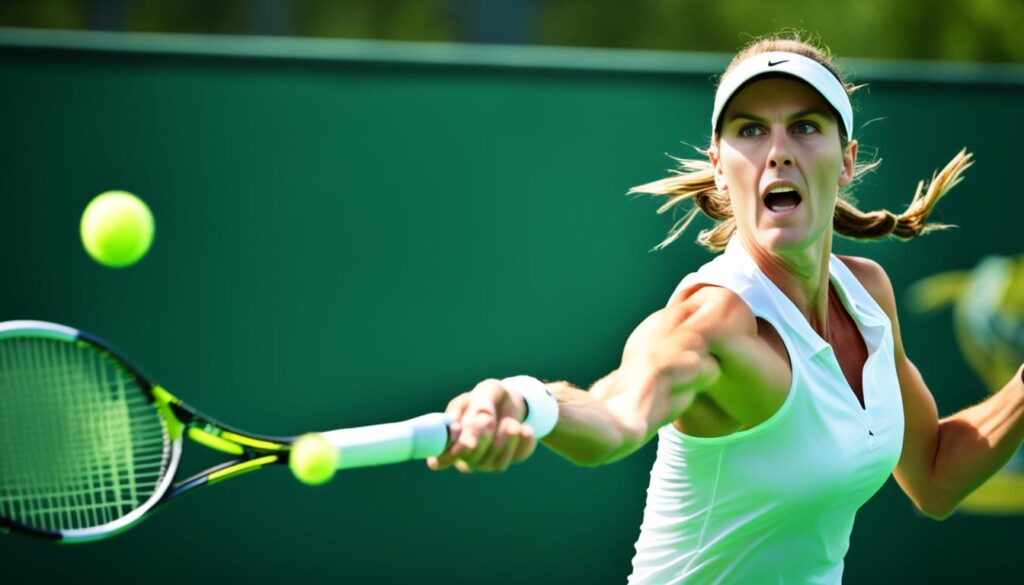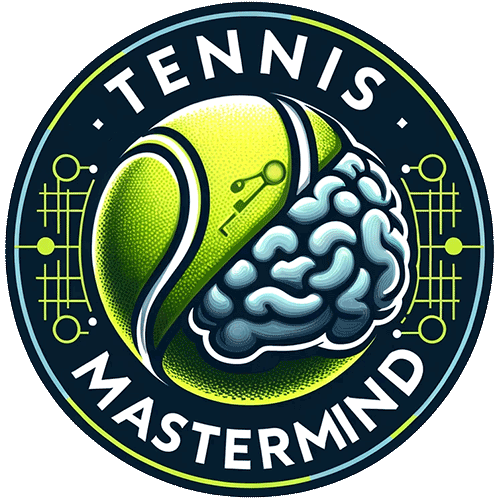Defensive techniques are crucial for success in tennis. By implementing strategic defensive strategies, players can neutralize their opponent’s strengths, disrupt their rhythm, and convert defense into offense. In this article, we will explore various defensive techniques in tennis, including aggressive patience, out-rallying the opponent, playing to your strengths, attacking the opponent’s weaknesses, and using variety to create mistakes. These techniques, when used effectively, can elevate your game and help you win matches.
Key Takeaways:
- Implementing defensive strategies in tennis can neutralize opponents and provide opportunities for success.
- Aggressive patience is a smart approach to winning, minimizing bad shot selection while maintaining an attacking mindset.
- Out-rallying the opponent and playing aggressively disrupt their rhythm and create opportunities to take control of the point.
- Players can exploit weaknesses and use variety to create mistakes, gaining the initiative and neutralizing opponents’ strengths.
- By mastering defensive techniques, players can elevate their game and improve their chances of success on the court.
Aggressive Patience: A Smart Approach to Winning
When it comes to tennis, a strategic approach can make all the difference in securing victory on the court. One tactic that stands out among the rest is aggressive patience. This technique allows players to minimize bad shot selection and unforced errors while still maintaining an attacking mindset. It’s all about finding the perfect balance between control, precision, and offensive play.
With aggressive patience, players exhibit a smart and efficient game that keeps their opponents on their toes. By exercising restraint and controlling their attacking instincts, players can navigate the game with composure and confidence. It’s about taking a step back to take two steps forward.
Trading patience is a key element in implementing the principles of aggressive patience. By waiting for the right opportunity to strike, players can maximize their chances of success. This strategic approach helps minimize the risk of unnecessary mistakes and opens up opportunities for strategic shot placement.
Another crucial aspect of aggressive patience is playing set-up shots. By strategically positioning the ball and setting up the perfect shot, players can put themselves in a favorable position to dominate the point. This calculated move enables players to control the tempo of the game and dictate the play.
Hitting high percentage first serves is also vital in the pursuit of aggressive patience. By consistently landing reliable first serves, players can gain an early advantage in the point. This not only puts pressure on their opponents but also provides an opportunity for a more controlled and aggressive follow-up shot.
Overall, the implementation of aggressive patience in tennis requires a strategic mindset, control over attacking instincts, and the ability to adapt to different situations. By incorporating these elements into their gameplay, players can enjoy a smart and efficient game while improving their chances of emerging victorious on the court.
Implementing aggressive patience in tennis can lead to a smart and efficient game, ultimately increasing the chances of winning matches.
Strategies to Out-Rally the Opponent and Play Aggressively
Out-rallying the opponent and playing aggressively are two key defensive strategies in tennis. These techniques not only disrupt the opponent’s rhythm but also provide opportunities to take control of the point. By focusing on consistency, depth, and control, players can force their opponents into making mistakes, ultimately gaining an upper hand in the match.
When aiming to out-rally the opponent, the primary objective is to maintain a consistent and controlled game. By executing well-placed shots and maintaining a deep ball trajectory, players can apply pressure and force their opponents to make more errors. Consistency is the key to pushing the opponent out of their comfort zone and creating opportunities to take control.
Playing aggressively involves channeling energy and intensity into every shot. Players should aim to hit the ball hard, catching the opponent off guard and putting them on the defensive. By playing aggressively, players can dictate the pace of the game and force the opponent to react rather than control the rally themselves. The element of surprise and intensity can often lead opponents to make mistakes, giving players the advantage.
Playing aggressively disrupts the opponent’s rhythm and enables us to set up shots that put them on the defensive. It’s an aggressive playstyle that forces the opponent to react quickly and make errors, giving us the upper hand and control of the game.
Setting up shots is crucial to executing an effective aggressive game plan. By strategically placing shots, players can create opportunities to attack and force the opponent into unfavorable positions. A well-set-up shot can force the opponent to move out of position or be off-balance, making it easier to execute winning shots and secure points.
Additionally, high percentage first serves play a significant role in out-rallying the opponent and playing aggressively. By consistently landing powerful and well-placed first serves, players can put immediate pressure on the opponent and give themselves an advantage right from the start. A strong first serve allows players to set the tone of the match and maintain control over the rallies.
The Importance of High Percentage First Serves
High percentage first serves not only minimize the risk of double faults but also apply pressure on the opponent, making it harder for them to anticipate the placement of the next shot. A strong and reliable first serve allows players to take charge of the game, gain the upper hand, and force the opponent into defensive positions. It sets the foundation for playing aggressively and out-rallying the opponent.

By out-rallying the opponent and playing aggressively, players can utilize effective strategies to control the game and force mistakes. Consistency, well-placed shots, and powerful first serves all contribute to playing confidently and taking charge on the court. Implementing these strategies will boost overall performance and increase the chances of winning matches.
Exploiting Weaknesses and Using Variety to Create Mistakes
To effectively defend against an opponent in tennis, we must exploit their weaknesses and use variety to create mistakes. By identifying and targeting their weaker side, mixing up spins, and capitalizing on second serve returns, we can seize the initiative and gain control of the match.
When facing an opponent, it is crucial to analyze their game and identify areas where they are vulnerable. By exploiting their weaknesses, we can force them out of their comfort zone and make them uncomfortable. Whether it’s a weaker forehand or a tendency to struggle with high balls, we can strategically direct our shots to exploit these weaknesses and disrupt their rhythm.
Using variety in our shots is another powerful tool to create mistakes and keep our opponents off balance. By changing the pace, angle, and spin of our shots, we can make it difficult for our opponents to anticipate and respond effectively. Mixing up spins, such as adding topspin, slice, or even hitting flat shots, can make it challenging for our opponents to adjust and find their timing.
“Variety is essential in tennis. It keeps your opponent guessing and puts pressure on them to constantly adapt.” – Rafael Nadal
A particularly opportune moment to exploit weaknesses and create mistakes is during second serve returns. Second serves are usually weaker than first serves, so by aggressively attacking them, we can pressure our opponents and prevent them from gaining an advantage in the point. Seizing the initiative with powerful returns or well-placed shots can force errors and put us in control from the start.
Understanding our opponents’ physical and mental limitations is also crucial. By recognizing their strengths and weaknesses, we can develop effective strategies to neutralize their strengths and exploit their limitations. For example, if an opponent lacks mobility, we can aim to hit wide shots and force them to move laterally, putting them under pressure and limiting their options.
By exploiting weaknesses, using variety, and capitalizing on opportunities, we can successfully defend against our opponents and gain an advantage in tennis matches. By strategizing and adapting to the situation, we can turn defense into offense and elevate our overall game.
Conclusion
Defensive techniques are the key to success in the game of tennis. By implementing a range of strategies such as aggressive patience, out-rallying the opponent, playing to your strengths, attacking weaknesses, and using variety, you can elevate your game and significantly improve your chances of winning matches.
Strategic thinking and adaptability are vital in defensive play. It is essential to remain composed and mentally strong, constantly assessing the situation and adjusting your tactics accordingly. By mastering defensive techniques, you can effectively turn defense into victory and achieve success on the tennis court.
Remember, it’s not just about blocking shots and reacting to your opponent’s moves. Defensive play involves actively disrupting their rhythm, forcing errors, and taking control of the point. By using a combination of patience, consistency, and smart shot selection, you can neutralize your opponent’s strengths and take the upper hand in the match.
So, don’t underestimate the power of a solid defense. By honing your defensive skills and integrating them into your overall game plan, you can elevate your game to new heights and emerge victorious in your tennis matches. It’s time to take your tennis game to the next level with a strong defense!




